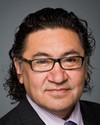Thank you so much, Madam Chair, for the honour of being here. Wachiya. Hello. Bonjour.
I'm presenting here today from the Cree First Nation of Waswanipi. I had a PowerPoint presentation, but I only found out on Thursday night about this, so although I did the best I could, I failed to submit it on time. I'll be just looking over notes. I gave a copy to Mr. MacPherson to hand out after the fact.
My name is Timothy Saganash Stringer. I'm the fire chief of Waswanipi. I've been the fire chief there for five years. I've been a certified firefighter for 15 years, levels 1 and 2, and I also have extensive training in instructing and in fire officers, which are very important courses.
In 2003, I graduated in Alberta. I'm from Quebec. The reason it was Alberta is that in Quebec all the courses are mainly in French. As Crees, we were looking for somewhere that has a very good rescue equipment that we could actually get our hands on and actually get the real feeling of experience. We went to Lakeland College in Vermilion, Alberta. They have a program called “fire etc.” That's why I graduated from over there.
It's been a goal of mine to be a firefighter since I was a kid, so here I am today, in the big House. Thank you again for having me. I'm honoured.
In Waswanipi, we have a mission statement that we let all our volunteers know, protecting our community any time, any place. The mission statement is this: “Through dedication and professionalism, members of the Waswanipi Fire Department cares and protects lives, property, and environment of our community through incident response, comprehensive training, public education, and fire prevention.”
The community of Waswanipi is located in northern Quebec, just north of the 49th parallel. We're a population of about 2,500 people, give or take, with doctors, teachers, and people who come in from out of town to help. Our department consists of five full-time employees—the fire chief, deputy fire chief, fire prevention officer, and also two captains—as well as contracted employees whom we hire through a special program. As well, we have 15 volunteers.
I wish I could put up the map here. I have a nice little map. You'll get an idea of it after the fact. We're about 122 kilometres away from a community that's south of us, so incident response time in getting the support that we need is too late. They're going to show up and help us pick up our hoses at that point. There's another community, Chapais, which 93 kilometres north. Again, if there's a burning house or we need more personnel to help us out, we're on our own. We're really on our own.
I also have another nice picture of the whole province of Quebec, showing all the native communities, the Cree native communities. Whapmagoostui is an isolated community. It's conjoined with the Inuit. There's no road to get there at this point. As you can just imagine, when they have a vehicle they need repaired, well, they have to send it on a boat and wait three or four months till it comes back. That's one big.... We need to fix something up for that.
You have to fly to get to the next community, Chisasibi. A couple of more hours away you get Wemindji, and a couple more hours away, Eastmain. Inland you have Nemaska. Again, on the southern part of James Bay, we have Waskaganish. We're the community that's the farthest south in the Cree nation, Waswanipi. Just northeast of us are Oujé-Bougoumou and Mistissini. We're all about two or three hours away from each other.
For my drive, to get here today, it took me seven hours. All the manufacturers are based around Montreal, Ottawa, and Toronto. Every time somebody has a truck to fix—well, as you can imagine, if you're living way up north, it's 15 to 20 hours to come down with a fire truck. As the presenters before me said, my fellow Mi'kmaq brothers, to change a light bulb is a lot more complicated than it seems. It's a big task. It shouldn't be that hard; unfortunately, but it is.
My fire department consists of four emergency vehicles: a first responder pickup truck; an aerial ladder truck, the year 2011; a 2000 pumper truck, which has a lot of water within it; and a rescue truck that has a bunch of emergency tools. We're very fortunate in my region.
I can imagine that in other departments.... I've visited other departments in Canada where they have just a simple garage with one truck they don't touch, or three bunker gears, and that's it. That's their fire department. We've benefited by having a bit of support from the federal government and support from our regional government because of the mining, the forestry, and the hydro.
Our fire department has other needs that we have identified. All the fire chiefs in my region get together at least four times a year just to go over problems and our goals to make our service better. We identified certain needs, such as rescue boats. Those are hard for us to obtain. We have big lakes. James Bay is right on the coast, and we don't even have rescue boats.
As for Ski-Doos, some departments have fought and got them, but our department is fighting to try to get that type of rescue equipment. It's hard. We get a lot of snow. Winter is nine months a year for us.
There's also a need for four-wheelers. A lot of the roads are rural and they're not paved. To get to people's camps for search and rescue we need four-wheelers to try to access them with rescue sleds.
We also need specialized all-terrain vehicles. There are a variety of what they could be, along with their equipment. We need a tanker truck that could hold lots of water. We're fortunate in our community to have hydrants, but they don't go down the road to our dump. We have a lot of dump fires, unfortunately, and forest fires in the area.
I have a nice picture of my organogram—fire chief, deputy fire chief, fire prevention officer, two captains, two lieutenants, and the volunteer firefighters below that—but when I first started, I was alone. I was one person doing fire prevention and the one person doing the maintenance on the truck. I fought with my band—not fought; we worked together—and it was beneficial to employ more people so we could take proper care, do proper training, and also serve the public in fire prevention. These are very important, in my opinion.
I'm so thankful for volunteers, although just like the community that presented before, it's hard to recruit volunteers from 2,500 people. Not everybody wants to be a firefighter. We're constantly trying to encourage people and we try to work with them and try to give them prizes to stick with us, but retaining them afterwards is another challenge on its own. They try it for a year and then decide it is not for them. We need the manpower in our departments.
I was outside a few minutes ago talking with my captain, Terrence Dixon. He was telling me that they're asking us to do certain services in the community, but we don't have anybody on call. There are just four of them right now. We shouldn't have this problem.
In my department, out of the 23 guys and girls we have—and we do have girls as well, which we're very proud of—most of us are under the age of 25. Saying they've been a firefighter for five-plus years is rare in my department. I've also worked on the south shore of Montreal, in Saint-Basile, and there are firefighters there who are 30, 40, and 50 years old, and those veterans taught a lot of the young guys. That was most important, and I wondered why.... I have tried recruiting people with licences because there are only five of us in the department who have licences, and it's very difficult. It's another challenge in the north to have people to go—it's an hour and a half away, one-way—to get their licence. You have to do that twice, plus the amount of time to do your driving course. Today when you go to the driver's bureau, you have to do all the courses before you actually.... It's a lot of time, it's a lot of money, and it's far, so that's why it's another struggle for us to get licences in the communities.
I have a slide here that shows the average salary of fire chiefs or fire personnel in general. We're $20,000 below the minimum salary in a lot of these positions. Why does a 40-year-old not want to work at the fire department? Because we can't even pay him. He can be a janitor somewhere else and make more money, unfortunately. At $15 an hour, you put your life on the line and absorb all these toxins. You're essentially going to join the fire department and get cancer when you retire, unfortunately. That's the new....
I'll try to speed it up. I have a list of my certified—




